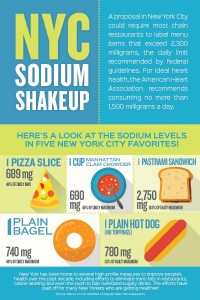 WESTFIELD – Whether you’ve seen “low sodium” foods at your local grocery store or heeded your doctor’s warning to reduce your salt intake, you may be aware that sodium is linked to many health risks and conditions. Sodium, a component of table salt, is a mineral found in many foods. Consuming too much of this prevalent mineral may contribute to high blood pressure, which causes 2/3 of strokes, along with heart failure. Many diabetics also have concurrent high blood pressure or take medications to lower blood pressure. Therefore, monitoring your intake of high sodium foods is an important aspect in prevention of these conditions.
WESTFIELD – Whether you’ve seen “low sodium” foods at your local grocery store or heeded your doctor’s warning to reduce your salt intake, you may be aware that sodium is linked to many health risks and conditions. Sodium, a component of table salt, is a mineral found in many foods. Consuming too much of this prevalent mineral may contribute to high blood pressure, which causes 2/3 of strokes, along with heart failure. Many diabetics also have concurrent high blood pressure or take medications to lower blood pressure. Therefore, monitoring your intake of high sodium foods is an important aspect in prevention of these conditions.
Reading the nutrition label may open your eyes to the sodium content of your food. This is especially true when you consider the serving sizes on the label, which can often be misleading. Large amounts of sodium can be found within packaged foods, canned vegetables and soups, salad dressings, lunch meats or processed meats like bacon/sausage, frozen entrees, cheese, snack foods, grains and many other products. Additionally, nearly all restaurants use a lot of added salt in their menu choices and recipes.
How much sodium should you have in a day? The most common daily sodium recommendation is no more than 2,300 mg. However, the American Heart Association recommends that you limit your sodium intake to 1,500 mg per day. Consider the fact that the average American consumes 3,500 milligrams (mg) per day (equivalent to half of a tablespoon). Some single entrees at your favorite restaurants can exceed 1,500 mg of sodium—this puts things into perspective! It is important to keep in mind that sodium restrictions may vary with different medical conditions, so speak with your doctor or registered dietitian for personalized recommendations.
Cutting back on sodium impacts your taste buds, so your preference for high salt foods may decrease over time. You can gradually desensitize your taste buds while maintaining taste by experimenting with fresh herbs, citrus juices, and strongly flavored foods (think vinegar, onions, and garlic) in place of added salt. Salt-free seasonings are another option. Additionally, choosing low-sodium product alternatives, eating more fresh/frozen vegetables (instead of canned), and preparing more meals at home from scratch can help to reduce your overall intake of sodium. Another tip is to increase your intake of potassium-rich fresh fruits and vegetables. This mineral has been shown to help reduce the negative affects of sodium in your diet.
If you are interested in learning more about nutrition counseling sessions with a registered dietitian at Baystate Noble Hospital, please call 413-568-2811 ex: 5671 for more information.


